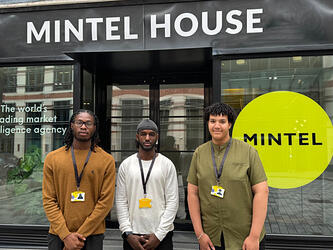Why fun matters in market research

Surveys probably aren’t the most exciting part of anyone’s day. When you send one out, you’re stepping into a moment where people could just as easily be scrolling TikTok, texting friends or watching a video.
That’s the reality we’re designing for – people are very easy to ‘lose’. So, if a survey feels conversational, light, and even a little fun, you’ll hold their attention and get more thoughtful answers back.
At Rival, in every research-on-research study we run, we’ve started asking participants to tell us if the survey was fun – not because we want to hand out badges or trophies, but because fun is a proxy for engagement, attention, and ultimately, better data.
What do we mean by fun?
For the purposes of this discussion, let’s define fun by three key metrics: easy, engaging and entertaining. How does the experience feel in the moment? This can be influenced by the tone of the questions, the flow of the conversation, the way people are invited to share their opinions, and more. Fun means the survey respects each person’s hyper-distracted reality and recognises the other options people have for their time.
Our latest research-on-research shows just how powerful fun can be. When we compared conversational surveys with traditional online formats, conversational experiences outperformed traditional surveys in terms of participant experience. People described them as more engaging ( 69% vs. 50%), more enjoyable ( 65% vs. 55%), and easier to complete ( 64% vs. 55%). And this wasn’t just Gen Z. Seventy percent of respondents aged 18–25 said conversational research was more engaging (vs. 52% for traditional). Almost identical numbers came from those 55 and older: 70% vs. 48%.
Better experiences also translated into better data. What made them enjoyable? People called out the natural flow, clear format, and the sense that they were being heard rather than herded through a form. One participant told us: “This survey felt more like a conversation. The format was consistent and easy to follow, which let me focus more on what I wanted to say.” Another said: “It felt like just a regular text conversation. That made me feel more invested in it and I felt comfortable, like I was texting a friend.”
That feeling shows up in the numbers. Open-ended responses in conversational surveys were 2.5x longer than traditional ones, and when we added in AI probing, they were five times longer. Video responses went almost eight times longer and scored the highest on our ‘thoughtfulness score’, which evaluates the relevance, specificity, clarity and empathic engagement of open-end responses. In side-by-side testing, themes pulled from conversational surveys were consistently rated higher on actionability, clarity and insightfulness.
Why fun drives quality
The academic research backs this up. Positive emotions broaden attention and promote cognitive flexibility, the raw ingredients of deeper processing and creativity. Curiosity and enjoyment allocate more cognitive resources to the task at hand, improving memory and engagement. A 2023 meta-analysis confirmed that curiosity-inducing designs consistently deliver better outcomes.
In other words: fun isn’t fluff. It creates the psychological conditions for more thoughtful responses.
What fun looks like in practice
Fun doesn’t mean gimmicks. It’s about small design choices that make participation feel more human. Sometimes that’s as simple as asking people to show us something instead of just telling us. For example, when testing different toy packaging concepts, you could have respondents record short videos about which box would grab their child’s attention rather than picking a picture from a grid. That extra step turned what could have been a dry exercise into something engaging, and it gave the client a richer, more emotional window into decision-making.
Other times, fun comes from framing. We once asked pet owners to ‘introduce us’ to their dogs and cats with photos and stories before diving into questions about treats and feeding routines. That moment of playfulness put people in a sharing mindset, and the responses that followed were far more thoughtful than if we’d jumped straight into brand attributes.
Even seasoned researchers notice it. When people try one of our conversational surveys at a conference booth, we often hear: “Hey, that was kind of fun.” That’s the point: when an experience feels enjoyable, people lean in, give more of themselves, and the data you get back is that much stronger.
A call to the industry
Fun may sound like a lighthearted concept, but it deserves a place in serious research design. It is a metric that translates directly into better attention, heightened thoughtfulness and increased data quality.
If people describe your survey as fun, what they’re really saying is that they stayed with it and gave you a little more of themselves. That’s exactly what good research depends on!
Jennifer Reid is co-chief executive and chief methodologist at Rival Group, the parent company of Rival Technologies, Reach3 Insights and the Angus Reid Group

We hope you enjoyed this article.
Research Live is published by MRS.
The Market Research Society (MRS) exists to promote and protect the research sector, showcasing how research delivers impact for businesses and government.
Members of MRS enjoy many benefits including tailoured policy guidance, discounts on training and conferences, and access to member-only content.
For example, there's an archive of winning case studies from over a decade of MRS Awards.
Find out more about the benefits of joining MRS here.













0 Comments